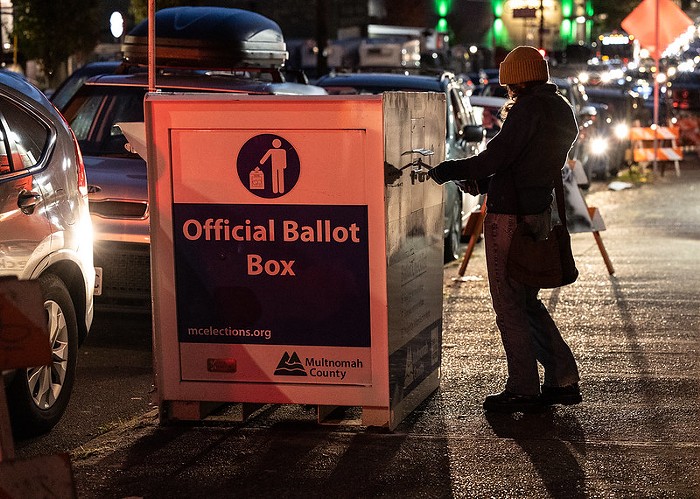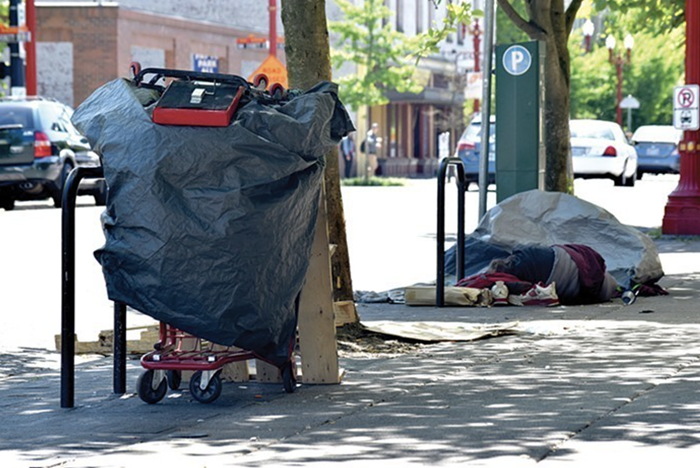IT WAS, the high-priced attorney said, "the greatest fear" for the Morrison Bridge. "An emergency."
In mid-January, workers inspecting the city's busiest non-highway span turned up something far more disturbing than the loose screws and damaged surface panels that have plagued the Morrison for years.
During a hastily scheduled inspection of the Morrison's north-most lane—one that ferries thousands of cars racing off Interstate 5 into the city every day, and seemed to be sagging—a Multnomah County crew found crucial structural pieces of the three-year-old deck were breaking dramatically apart. Whole sections of the bridge's surface were unmoored when they should have been locked soundly in place for long years to come.
"The bridge is crumbling," Joel Mullin—an attorney with the upscale Portland firm Stoel Rives representing the county in an ongoing lawsuit—told a Multnomah County judge January 16. "The deterioration has accelerated more than anticipated."
The Morrison's troubles are nothing new. A lawsuit over the project has been chugging along since shortly after the deck was installed in 2012, and grown steadily as new litigants and claims have jumped into the fray. For more than a year, the Mercury has used public records, court filings, and interviews with key officials to highlight missteps that may negate millions spent on the bridge's new deck.
But now there's much more.
As the bridge shows novel and alarming damage, hundreds of pages of newly released documents and court pleadings offer a troubling possibility: The Morrison Bridge project was doomed well before it started, and county officials should have known it.
Those officials can't be solely blamed for the bridge's failure, though. Filings also suggest the companies that supplied the now-crumbling decking hid crucial questions about its quality from county staffers. The companies all say that's preposterous, but struggle to explain damning email exchanges.
Whatever the case, the outcome is there for all to see. An entire lane of the Morrison is closed, and no one's sure when it will be reopened, or if the damage will spread to other parts of the bridge. Adding to the drama is the county's chagrined announcement in July that it has to replace the deck—diverting funds from other bridge projects—and that it may wind up using the very same material that's failing on the bridge right now.
"Nothing's off the table," says Mike Pullen, a county spokesperson. But he notes: "We're studying other options. We know the problems with the deck that's out there."
THE MORRISON BRIDGE DEBACLE is labyrinthine, with curlicues of dysfunction shooting off in all directions. To get a sense of the sweep, you've first got to know the players involved.
First, there's Multnomah County, responsible for most of Portland's Willamette River bridges. The county has a staff of bridge engineers to oversee upkeep, and a lot of fresh work on its plate. The bridge department has to keep tabs on the gargantuan, over-budget Sellwood Bridge replacement. And it's preparing another multimillion-dollar project on the Broadway Bridge next year.
But back in 2011, the department was focused on the Morrison. Specifically, the county had decided to replace the dangerous, damaged steel grating covering the bridge's lift arms with something safer. To do that job, it hired Conway Construction, a smallish outfit based in Ridgefield, Washington. The Oregonian reported there was grumbling at the time from county staffers who didn't trust Conway to do the job. But the company's estimate for the work—$4.3 million—was roughly $1 million lower than anyone else's. Conway got the gig.
The construction company first removed the existing, decades-old steel grate from the Morrison (a process that nearly derailed the whole project when its workers carelessly let pollutants fall into the Willamette River). Then, Conway purchased a new deck from North Carolina company ZellComp.
ZellComp is vital to the tale of the Morrison. At the time the company was hired, it was one of a handful offering up bridge decks made of a semi-experimental plastic called fiber-reinforced polymer, or FRP. Back in the early 2000s, the material was hailed by some as the future of highway infrastructure projects. It's light, strong, and holds up well in severe weather conditions. But it also had a spotty track record where bridges are concerned. And Multnomah County was looking to build the largest FRP deck the country had ever seen.
ZellComp, like Conway, just barely got picked for the Morrison project. County officials had quietly planned to scrap the traditional strategy of soliciting bids then choosing among the cheapest ones received. Instead, they wanted to sign with another company they'd deemed fit for the work. But ZellComp raised a fuss—forcing a bid process and winning the job.
The last twist was finding a manufacturer. Since ZellComp doesn't own production facilities—they only design and market their products—it was in the habit of working with companies that could produce custom pieces for each job.
And as ZellComp was on the cusp of landing the Morrison project, it decided to tap a manufacturer it hadn't worked with before: a Virginia outfit called Strongwell.
That December 2010 decision set into motion what the county now claims was a string of deceit on the part of Strongwell and ZellComp—a narrative that didn't become clear until the court case loosed mounds of documents from the companies.
"In fact," reads a pleading the county filed in December 2014, "Strongwell's 'performance' with respect to the manufacture of its panels and subsequent efforts to 'sell' the defective panels to the county is a study in deception."
IN JUNE 2011—not long after winning the Multnomah County job—Strongwell had a problem. The polymer it had produced for the Morrison's new deck was plenty strong, capable of withstanding more than the necessary 80,000 pounds of pressure. But testing on prototypes of the material made clear it couldn't satisfy the stiffness standards required on the bridge—a factor called "modulus."
So Strongwell staffers made an interesting call, according to internal records released in December as part of the court case. On June 14, preparing for a visit from a Multnomah County inspector, the company's head of quality control emailed colleagues to let them know they'd "attempt to sell what we have."
"The Oregon auditor will only be shown the average modulus initially and not the data from the failing sections of the part," wrote the Strongwell employee, Clint Smith. The decision, he added, was at the request of ZellComp's CEO, Dan Richards.
The county now claims Strongwell continued to tinker with the makeup of its product, but that none of it ever fully satisfied the stiffness requirements for the Morrison. Instead, the company relied on spot tests of multiple panels to certify the material was fit for the bridge, the county says.
"Strongwell never disclosed to the county the actual data," the county now says in court filings.
But there was a more apparent problem with the decking, once it arrived in Portland: It was already cracked.
In October 2011, with deck installation already underway, the county began to voice worries about thin cracks that were showing up along the base of crucial supports in the polymer panels.
"There are some cracks that certainly don't look very good," ZellComp's CEO wrote to Strongwell executives at the time, "but I need your assessment of whether or not you are confident that these are resin rich cracks and not structural defects."
The argument Strongwell and ZellComp would wind up making—to county officials and in court papers—is that the cracks weren't important. To this day, they don't even call them "cracks" if they can help it. To the companies, the distressing-looking seams were something called "crazes," harmless irregularities that sometimes show up in the type of polymer used on the Morrison.
Still, when the county had researchers at Portland State University run tests on decking with "crazes" and without, the cracked material proved slightly weaker. And privately, documents show, Strongwell employees voiced worries about the irregularities.

"Dan [Richards] is suggesting the cracks are resin rich cracks and crazes, but based on the photos from Conway Construction, I think we have a much more serious issue," Strongwell Vice President Glenn Barefoot wrote in an October 2011 email. Later that day he wrote: "I am concerned about installing these deck sections knowing there are cracks in the flanges."
Strongwell immediately set about checking its warehouse for Morrison Bridge pieces that hadn't yet shipped. Of 60 pieces checked, 58 had the same type of cracks, records show. Two were so bad they had to be held back entirely. The remaining 56 were slathered in epoxy to cover the imperfections.
Worry over the decking persisted. Nearly a month after Multnomah County expressed concern over the cracks, and while ZellComp officials were offering assurances the defects were merely superficial, a Strongwell quality control staffer wrote to a colleague: "Using some of those deck panels scares me. We're not short timers here like some. Using them may come back in a bad, bad way."
Throughout all this fretting, the county claims it was purposefully left in the dark.
"ZellComp (with Strongwell's knowledge) continued to assure the county not to worry, that even the defects the county had uncovered would not affect performance," the December pleading says. "ZellComp and Strongwell went so far as to rename the cracks as crazes to avoid the contract specifications that permitted rejection of panels exhibiting cracks."
THERE WAS ANOTHER worrisome factor Strongwell took pains not to mention, documents suggest.
The company actually ran two batches of polymer material for the Morrison—one for the bridge's southern half and the other for the north. And that second batch? It was weaker than the first. Tests showed the material could still withstand more than the required 80,000 pounds of pressure, but that was significantly less than the 90,000-plus pounds the first batch could hold.
At Strongwell and ZellComp, no one had any idea why the second batch was underperforming. In an email exchange discussing the testing results and other issues, Strongwell VP Barefoot made clear he wanted to keep the information quiet.
"We just need to continue communicating with each other and ensure we resolve these issues between ourselves," he wrote, "and not involve the contractor or Multnomah County."
Today, it's the north side of the bridge—decked in material from the second batch—that has failed the worst. And that failure is spectacular.
In video footage, shot by Multnomah County and obtained by the Mercury via records request, it's evident that deck panels in the Morrison's north lane have deteriorated far worse than officials anticipated. The video shows county bridge staffers watching in increasing alarm as whole sections of paneling are found severed at crucial points, visibly undulating with light pressure.
It had been clear for over a year the bridge's screwed-on top sheets were coming loose, but this footage, filmed in mid-January, was the first sign important base pieces of the Morrison were breaking apart. And those pieces, the county has made clear, are not safe for vehicle traffic.
In 2012, no one foresaw this. Back-and-forth emails about cracks continued for months, with the county at one point announcing it would reject an entire portion of the deck panels. But Strongwell insisted that new panels could take months to produce, and in the end the county—satisfied by Portland State University's testing of the material—accepted all of Strongwell's material for the bridge.
As the Mercury has reported ["Fingers Crossed," News, Oct 16, 2013], the county's head bridge engineer, Ken Huntley, made clear he could have rejected the panels based on cracks and patches of missing material, but the county didn't want to add costs or time to a project that was already going to come in nearly a million over budget and months behind schedule.
The Morrison began showing defects mere months after it reopened to car traffic in March 2012.
IT SHOULD BE NOTED—all the statements in their own emails aside—that Strongwell and ZellComp take exception to the story the county paints.
"The county has taken the thousands of documents produced in the case and 'cherry-picked' them to present a one-sided attack on Strongwell, leaving out nearly all of the crucial facts," Strongwell wrote in a December 31 reply to the allegations of deception.
Strongwell says Multnomah County's lawyers have misrepresented test results on the decking's stiffness and that those results were shown to officials according to industry standards. Strongwell also claims the worries voiced by its employees over cracks happened early on, before subsequent testing apparently revealed they were no big deal.
And the company says it communicated all of its doubts and difficulties to ZellComp, the only entity with which it actually had a contract in the deal.
"The county's case boils down to the county asserting that there were a few things about the Strongwell production process that it claims it was unaware of," Strongwell said in the December filing.
(The company, in its reply, doesn't address a few key things, like the fact one of its executives actively advocated keeping Multnomah County out of the loop in certain discussions. Strongwell's attorney, when asked about this, said he didn't recall those comments.)
Strongwell's main assertion, repeated again and again, is that nothing was wrong with its product, and that the "crazes" had no bearing on the deck's performance.
"We said all along everything we supplied met the specifications," Barefoot told the Mercury in a brief conversation. "The product that they have was not inferior. It's just a nasty mess that's developed out there."
ZellComp and its attorney wouldn't comment for this story. But in a pleading filed on January 23 the company called Multnomah County's accusations "all sizzle, no steak."
ZellComp maintains the county didn't install the decking according to plan, adding an additional fiberglass layer atop the product. But even in making that point, the company quotes an email in which its CEO said, "I'm sure it will be fine," when told of the modification.
ZellComp also says the county waited far too long to repair the deck, contributing to the damage we're seeing today.
ZellComp and Strongwell, by the way, aren't the only players the county blames for its bridge misfortunes. It's also repeatedly accused the main contractor, Conway Construction, of poor workmanship in the project. Conway, of course, denies this.
THE COUNTY MIGHT DO WELL to also look inward when assigning blame for the Morrison debacle. It appears there was ample evidence—no matter what concerns were or weren't shared—that the ZellComp decking could prove problematic for the Morrison. But county officials never sought that evidence out.
In 2009, well over a year before ZellComp was awarded the Morrison project, the Florida Department of Transportation (FDOT) used the company's wares for an experiment.
Just like Multnomah County, Florida was seeking a new, lighter bridge surface that could replace slippery steel grating. So officials picked a tiny, out-of-the-way bridge amid the sugarcane fields of Southeast Florida, and spent a few hundred thousand dollars fitting it with a new ZellComp deck.
"It worked great for a year and then all of a sudden started breaking up bad, fast," says John Danielsen, a maintenance engineer with FDOT who worked on the project. "It took a year of constant maintenance. Every month, every week."
The problems were similar to what the Morrison has experienced, though less severe. Deck panels began to show through an asphalt-like top layer. Screws popped loose. Panels cracked. The bridge was never in serious danger of dumping cars into the water, Danielsen says, but might have easily developed holes that could puncture car tires and cause other accidents.
And the bridge carried little traffic—nothing close to the 50,000 cars a day that cross the Morrison.
"We put it in the most out-of-the-way spot that we could think of, because we did not want what Portland has," Danielsen says.
Florida officials, like Multnomah County, soon decided the deck was beyond repair. The bridge has since been fit, once again, with steel grating.
Dramatic deterioration isn't the only similarity between the Florida and Portland projects.
ZellComp employed the same engineering firm for the Florida bridge as it did with the Morrison—New York-based Hardesty & Hanover (H&H). And the firm used similar calculations when developing both projects.
Now, Multnomah County says it's learned H&H made miscalculations on the Florida project, and claims in court the engineering firm never mentioned the failed bridge when it was tapped to work on the Morrison. (It appears Multnomah County didn't learn about the Florida bridge until Danielsen read of the Morrison's problems and called county staff.)
"This is no small matter," the county writes in a December court filing. "Because H&H did not disclose to the county that the deck on the Belle Glade (Florida) bridge had failed, the county proceeded with the project using the defective design H&H prepared and stamped."
The engineering firm, meanwhile, says it presumed county staff had already thoroughly examined the ZellComp system.
"I just assumed," one H&H employee said in sworn testimony, "that the parties that decided to put this system on the Morrison Bridge would have done the necessary research."
If it had been on the lookout for warning signs, the county might also have spied some in Virginia. In 2009, the Virginia Department of Transportation released a report about ZellComp's bridge decks. The decks worked fine on flat bridges, researchers concluded, but showed worrying weaknesses on arcing spans like the Morrison.
But again, officials didn't learn about the study until after the Morrison began to fail. Even then employees said it wouldn't matter. Head bridge engineer Huntley told attorneys the Morrison didn't slope as much as the bridge in the Virginia report, and therefore wouldn't cause as much strain.
There was local evidence, too.
The Oregon Department of Transportation began experimenting with FRP decking in 2002 on two bridges in Astoria, and met with almost immediate disaster. The asphalt surface began sloughing off one bridge and had to be replaced. The deck on the other bridge began cracking within a year, and saw more serious damage by the four-year mark. It was replaced with a steel grating after eight years. Court documents indicate county staffers were aware of the failures.
And they were certainly aware of their own troubles. In 2005, the county installed FRP decking (from a manufacturer other than ZellComp) on the Broadway Bridge. As we've reported ["Water Under the Bridge?" News, Aug 21, 2013], an engineering report later found the panels had begun to crack and come apart, and were slowly filling with water, adding weight to the balance-sensitive drawbridge.
The county ultimately switched some panels out, and the decking remains in good shape on the Broadway.
TODAY, THE FAILED MORRISON BRIDGE deck project has shattered the rosy $4.3 million projections of 2011.
A county spokesperson puts the total number spent on construction—including an eventual settlement with the contractor over a work stoppage—at more than $5.2 million. (The federal government paid most of that, but it's money that could have gone to other, better projects nonetheless.) On top of that, the county's spent at least $619,000 repairing damage to the deck, court documents show.
And the county refuses to say how much it's paid the attorneys hired to handle the ongoing court case, claiming such information is related to litigation.
Whatever the total, the portion of that money officials ultimately recoup—and whether they'll recoup any at all—will depend on the outcome of the lawsuit, which involves seven parties, and enough attorneys that Multnomah County Circuit Judge Karin Immergut will borrow a larger courtroom if the case goes to trial next month, as scheduled.
A thornier question is what will become of the Morrison Bridge, limping gamely by with a closed lane and no end to its trouble in sight.
In July, officials announced the Morrison's deck was beyond repair, and needed to be replaced. The county indicated it was done experimenting with polymer, and would either revert to a steel grating or pursue an experimental aluminum deck.
Then, just a few months later, it took that back.
It turns out Multnomah County is once again hoping the federal government will pay for a new deck on the Morrison Bridge. And the feds aren't so sure polymer is a lost cause.
"They would like us to continue to explore these options, including FRP," county spokesperson Pullen said in November.
That's problematic, because it turns out the number of companies offering polymer bridge decks has dwindled since the Morrison's was purchased in 2011. If the feds decide they want to pay for polymer once again, the only option available right now is ZellComp. As in, the people the county is suing. The same people officials claim sold us a defective deck and lied about it.
The county now says it's looking into other options—like strengthening the bridge and finding a viable deck that's not steel, aluminum, or FRP.
If it falls back on polymer, though, Portland would be taking a bold step where others fear to tread. In talking with Danielsen, the Florida bridge engineer, the Mercury asked if the state of Florida would ever consider using FRP decking again. There was no hesitation.
"No, we will not," he said. "Once you have one failure, it kind of sours the whole thing."

- Photo by Adam Wickham
READ OUR PAST COVERAGE:
• "(Un)Screwed," News, August 7, 2013
• "Water Under the Bridge?" News, August 21, 2013
• "Fingers Crossed," News, October 16, 2013
• "Getting Decked," July 9, 2014
• "Come Shudder At This Video of Damage on the Morrison Bridge," Blogtown, January 23



















